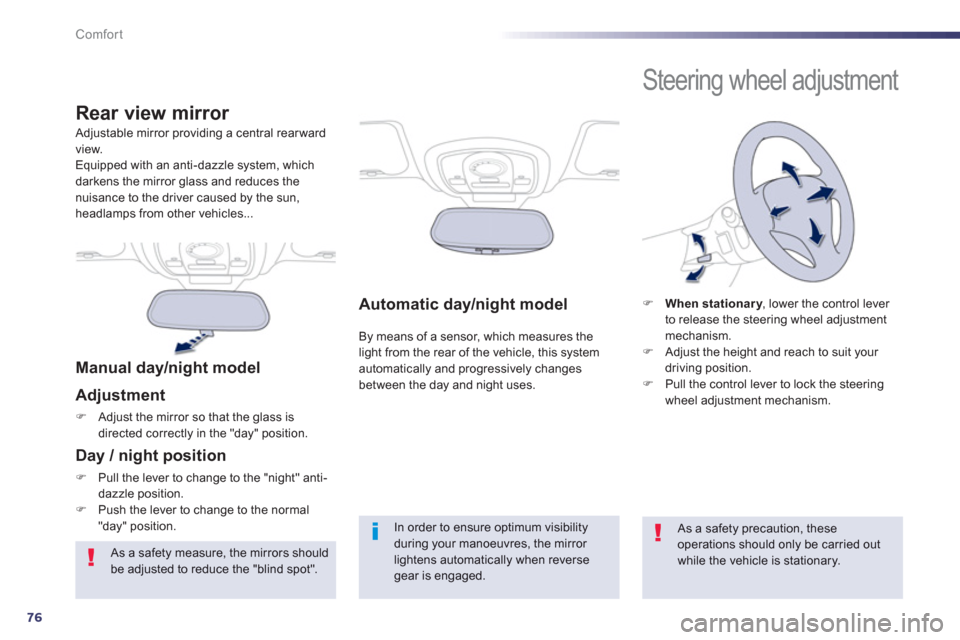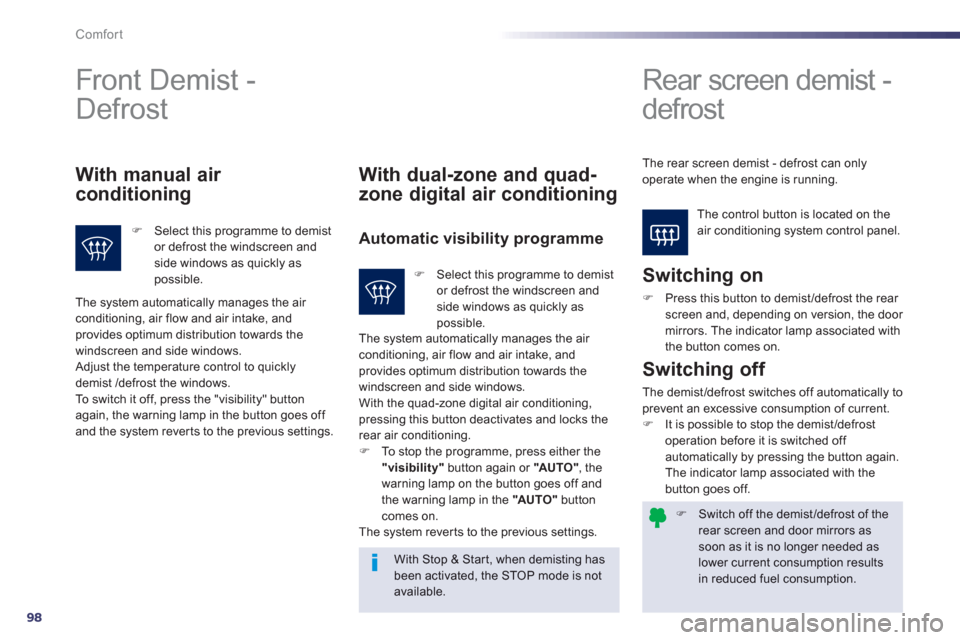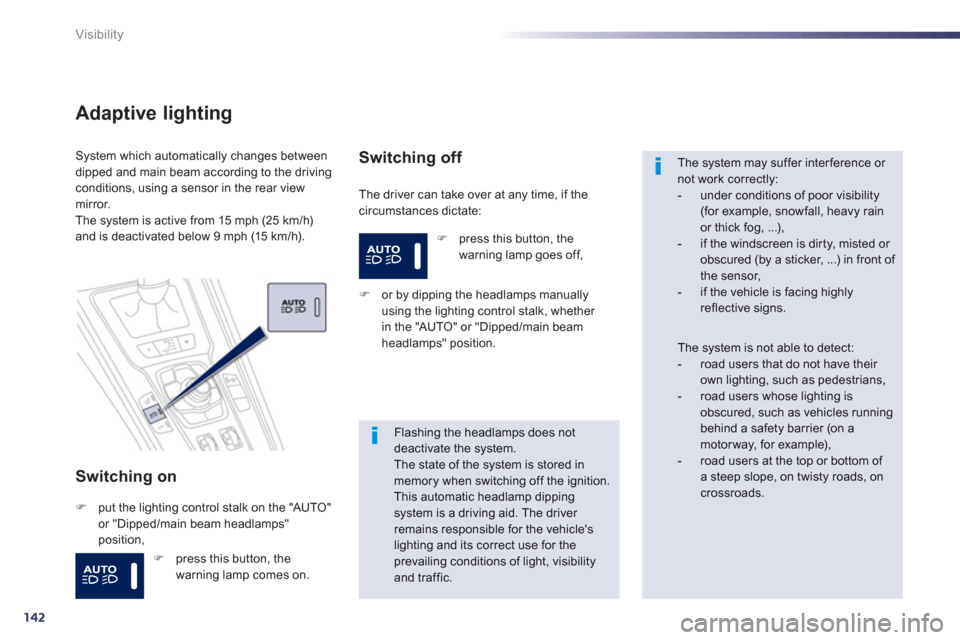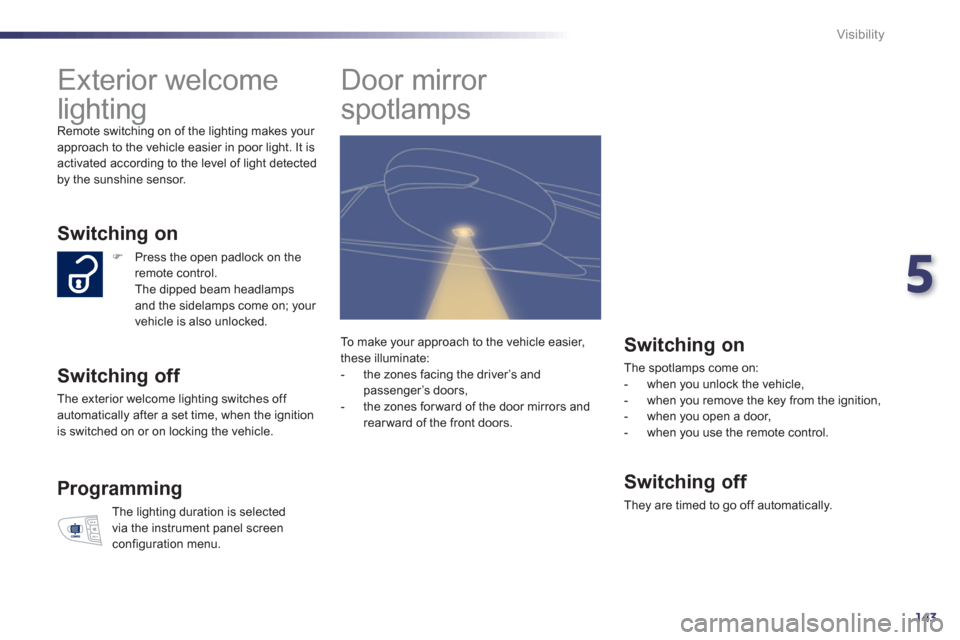2013 Peugeot 508 Hybrid mirror
[x] Cancel search: mirrorPage 77 of 340

3
75
Comfort
Automatic tilting in reverse gear
System which provides a view of the ground
during parking manoeuvres in reverse gear.
Programming
F
With the engine running, engage reverse gear.F
Select and adjust the left-hand and right-hand mirrors in succession.
The adjustment is stored immediately.
Switching on
FWith the engine running, engage reversegear. FMove control A
to the right or to the left to select the corresponding mirror.
The glass of the mirror selected tilts downwards, in accordance with its programming.
Switching off
FExit reverse gear and wait ten seconds.or
FReturn control Ato the central position.
The mirror glass returns to its initial position.
The mirror glass also returns to its initial position:
- if the speed exceeds 6 mph (10 km/h),
- if the engine is switched off.
Page 78 of 340

76
Comfort
Automatic day/night model
By means of a sensor, which measures thelight from the rear of the vehicle, this system
automatically and progressively changes
between the day and night uses.
Adjustable mirror providing a central rear ward
view.
Equipped with an anti-dazzle system, which
darkens the mirror glass and reduces thenuisance to the driver caused by the sun, headlamps from other vehicles...
Rear view mirror
Manual day/night model
Adjustment
FAdjust the mirror so that the glass is
directed correctly in the "day" position.
Day / night position
FPull the lever to change to the "night" anti-
dazzle position.
FPush the lever to change to the normal"day" position.In order to ensure optimum visibility during your manoeuvres, the mirror lightens automatically when reversegear is engaged.
Steering wheel adjustment
FWhen stationary, lower the control lever yto release the steering wheel adjustment mechanism. F
Adjust the height and reach to suit your
driving position. F Pull the control lever to lock the steeringwheel adjustment mechanism.
As a safety precaution, these operations should only be carried out while the vehicle is stationary.
As a safety measure, the mirrors should be adjusted to reduce the "blind spot".
Page 100 of 340

98
Comfort
F Switch off the demist/defrost of the rear screen and door mirrors assoon as it is no longer needed as lower current consumption results in reduced fuel consumption.
Front Demist -
Defrost
Rear screen demist -
defrost
The control button is located on theair conditioning system control panel.
With manual air
conditioning
F Select this programme to demistor defrost the windscreen and side windows as quickly aspossible.
With dual-zone and quad-
zone di
gital air conditioning
Automatic visibility programme
Switching on
F
Press this button to demist/defrost the rear screen and, depending on version, the door mirrors. The indicator lamp associated with
the button comes on.
With Stop & Star t, when demisting has been activated, the STOP mode is not available.
Switching off
The demist/defrost switches off automatically toprevent an excessive consumption of current. F
It is possible to stop the demist/defrost
operation before it is switched off automatically by pressing the button again.
The indicator lamp associated with the
button
goes off.
The system automatically manages the air conditioning, air flow and air intake, and provides optimum distribution towards the
windscreen and side windows.
Adjust the temperature control to quickly
demist /defrost the windows.
To switch it off, press the "visibility" button again, the warning lamp in the button goes off
and the system rever ts to the previous settings.
F Select this programme to demist or defrost the windscreen andside windows as quickly as possible.
The system automatically manages the air conditioning, air flow and air intake, and
provides optimum distribution towards the
w
indscreen and side windows.
With the quad-zone digital air conditioning,
pressing this button deactivates and locks the
rear air conditioning. F To stop the programme, press either the "visibility"button again or "AU TO "
, the
warning lamp on the button goes off and
the warning lamp in the "AU TO "buttoncomes on.
The system rever ts to the previous settings.
The rear screen demist - de
frost can onlyoperate when the engine is running.
Page 143 of 340

5
141
Visibility
The sidelamps and dipped beam headlamps are
switched on automatically, without any action
on the part of the driver, when a low level of external light is detected or in certain cases of
activation of the windscreen wipers.
As soon as the brightness returns to a sufficient
level or after the windscreen wipers are switched
o
ff, the lamps are switched off automatically.
Automatic illumination of
headlam
ps
Activation
FTurn the ring to the "AUTO"position. The automatic
illumination of headlamps is accompanied by a message in the instrument panel screen.
Deactivation
FTurn the ring to another position.
Deactivation is accompanied by a message
in the instrument panel screen.
Association with automaticguide-me-home lighting
Association with automatic illumination of headlamps provides the guide-me-home lighting with the following additional options:
- selection of the lighting duration of 15, 30
or 60 seconds,
- automatic activation o
f guide-me-home lighting when the automatic illumination of
headlamps is in operation.
Operating fault
In the event of a fault with the sunshine sensor, the lighting comes on, this warning lamp
is displayed in the instrument panel and/or
a message appears in the instrument panel screen, accompanied by an audible signal.
Contact a PEUGEOT dealer or a qualified
workshop.
In fog or snow, the sunshine sensor maydetect sufficient light. In this case, the lighting will not come on automatically. Do not cover the sunshine sensor,coupled with the rain sensor and located in the centre of the windscreenbehind the rear view mirror; theassociated functions would no longer be controlled.
Programming
Selection of the duration of theguide-me-home lighting is done
in the configuration menu vehicle
parameters, in the instrument panel screen.
Page 144 of 340

142
Visibility
Adaptive lighting
Switching on
The driver can take over at any time, if thecircumstances dictate:
System which automatically changes betweendipped and main beam according to the driving conditions, using a sensor in the rear view mirror.
The system is active from 15 mph (25 km/h) and is deactivated below 9 mph (15 km / h).
Fput the lighting control stalk on the "AUTO"
or "Dipped/main beam headlamps"
position,
Switching off
F
or by dipping the headlamps manually using the lighting control stalk, whether
in the "AUTO" or "Dipped/main beam
headlamps" position.
Flashing the headlamps does notdeactivate the system.The state of the system is stored in memory when switching off the ignition. This automatic headlamp dipping system is a driving aid. The driver remains responsible for the vehicle'slighting and its correct use for theprevailing conditions of light, visibility and traffic.
The system may suffer interference or not work correctly:
- under conditions of poor visibility(for example, snowfall, heavy rain or thick fog, ...),
- if the windscreen is dir ty, misted or obscured (by a sticker, ...) in front of the sensor,
- if the vehicle is facing highly reflective signs.
The system is not able to detect:
- road users that do not have their own lighting, such as pedestrians,
- road users whose lighting isobscured, such as vehicles running behind a safety barrier (on amotorway, for example),
- road users at the top or bottom of a steep slope, on twisty roads, oncrossroads.
Fpress this button, the
warning lamp goes off,
F press this button, the
warning lamp comes on.
Page 145 of 340

5
143
Visibility
Exterior welcome
lighting
Remote switching on of the lighting makes your
approach to the vehicle easier in poor light. It is
activated according to the level of light detected
by the sunshine sensor.
Switching on
Switchin
g off
The exterior welcome lighting switches off
automatically after a set time, when the ignitionis switched on or on locking the vehicle.
Programming
The lighting duration is selected
via the instrument panel screen
configuration menu.
FPress the open padlock on the
remote control.
The dipped beam headlamps
and the sidelamps come on; your
vehicle is also unlocked.
Door mirror
spotlamps
Switching on
The spotlamps come on:
- when you unlock the vehicle,
- when you remove the key from the ignition,
- when you open a door,
- when you use the remote control.
Switching off
They are timed to go off automatically. To m a k e
your approach to the vehicle easier,
these illuminate:
- the zones facing the driver’s and
passenger’s doors,
- the zones forward of the door mirrors andrearward of the front doors.
Page 151 of 340

5
149
Visibility
Automatic rain sensitive
windscreen wi
pers
The windscreen wipers operate automatically,
without an
y action on the par t of the driver, if
rain is detected (sensor behind the rear view mirror), adapting their speed to the intensity of
the rainfall.
Switching on
Briefly push the control stalkdownwards.
This warning lamp comes on in the
instrument panel and a message is
displayed.Brie
fly push the control stalk
downwards again, or place thecontrol stalk in another position (Int,
1 or 2).
This warning lamp goes off in the instrument
panel and a message is displayed.
Switching off
The automatic rain sensitive windscreenwipers must be reactivated by pushing the control stalk downwards, if theignition has been off for more than one minute.
Page 152 of 340

150
Visibility
Do not cover the rain sensor, linked with the sunshine sensor and located in the centre of the windscreen behind the rear view mirror. Switch off the automatic rain sensitivewipers when using an automatic car wash.
In winter, it is advisable to wait until thewindscreen is completely clear of ice before activating the automatic rain sensitive wipers.
Operating fault
If a fault occurs with the automatic rain
sensitive wipers, the wipers will operate in intermittent mode.
Have it checked by PEUGEOT dealer or a qualified workshop.
Special position of the
w
indscreen wipers
This position permits release of the windscreen
wiper blades.
It is used for cleaning or replacement of the blades. It can also be useful, in winter, todetach the blades from the windscreen.
To maintain the effectiveness of the "flat-blade" type of wiper blades, it is advisable to:
- handle them with care,
- clean them regularly using soapywater,
- avoid using them to retain cardboard on the windscreen,
- replace them at the first signs of wear.
F
Any action on the wiper stalk in the minute
after switchin
g off the ignition places the blades vertically on the screen.F To park the blades again, switch on theignition and operate the wiper stalk.